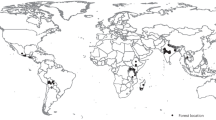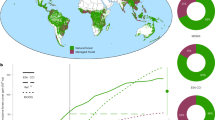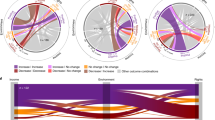Abstract
Forest restoration occupies centre stage in global conversations about carbon removal and biodiversity conservation, but recent research rarely acknowledges social dimensions or environmental justice implications related to its implementation. We find that 294.5 million people live on tropical forest restoration opportunity land in the Global South, including 12% of the total population in low-income countries. Forest landscape restoration that prioritizes local communities by affording them rights to manage and restore forests provides a promising option to align global agendas for climate mitigation, conservation, environmental justice and sustainable development.
This is a preview of subscription content, access via your institution
Access options
Access Nature and 54 other Nature Portfolio journals
Get Nature+, our best-value online-access subscription
$29.99 / 30 days
cancel any time
Subscribe to this journal
Receive 12 digital issues and online access to articles
$119.00 per year
only $9.92 per issue
Buy this article
- Purchase on Springer Link
- Instant access to full article PDF
Prices may be subject to local taxes which are calculated during checkout


Similar content being viewed by others
Data availability
Data for and from this analysis are available at the Harvard Dataverse (https://doi.org/10.7910/DVN/YUUXKU). The folder contains instructions for obtaining all input and output data that it does not contain due to size or sharing limitations.
Code availability
Code for analysis is available at the Harvard Dataverse (https://doi.org/10.7910/DVN/YUUXKU). The folder contains information on setting up the Docker container to reproduce analysis as well as static versions of software dependencies that are not part of the default Docker image.
References
Bastin, J. F. et al. The global tree restoration potential. Science 364, 76–79 (2019).
Lewis, S. L., Wheeler, C. E., Mitchard, E. T. A. & Koch, A. Regenerate natural forests to store carbon. Nature 568, 25–28 (2019).
Chazdon, R. L. & Brancalion, P. Restoring forests as a means to many ends. Science 365, 24–25 (2019).
Busch, J. et al. Potential for low-cost carbon dioxide removal through tropical reforestation. Nat. Clim. Change 9, 463–466 (2019).
Brancalion, P. H. S. et al. Global restoration opportunities in tropical rainforest landscapes. Sci. Adv. 5, eaav3223 (2019).
Strassburg, B. B. N. et al. Strategic approaches to restoring ecosystems can triple conservation gains and halve costs. Nat. Ecol. Evol. 3, 62–70 (2019).
Friedlingstein, P., Allen, M., Canadell, J. G., Peters, G. P. & Seneviratne, S. I. Comment on “The global tree restoration potential”. Science 366, eaay8060 (2019).
Lewis, S. L. et al. Comment on “The global tree restoration potential”. Science 366, eaaz0388 (2019).
Veldman, J. W. et al. Comment on “The global tree restoration potential”. Science 366, eaay7976 (2019).
Anderson, C. M. et al. Natural climate solutions are not enough. Science 363, 933–934 (2019).
Maron, M. et al. Global no net loss of natural ecosystems. Nat. Ecol. Evol. 4, 46–49 (2019).
Schleicher, J. et al. Protecting half of the planet could directly affect over one billion people. Nat. Sustain. 2, 1094–1096 (2019).
Mappin, B. et al. Restoration priorities to achieve the global protected area target. Conserv. Lett. 12, e12646 (2019).
Pritchard, R. & Brockington, D. Forests: regrow with locals’ participation. Nature 569, 630 (2019).
Potapov, P., Laestadius, L. & Minnemeyer, S. Global map of forest landscape restoration opportunities. World Resources Institute https://www.wri.org/applications/maps/flr-atlas/#&init=y (2011).
Oldekop, J. A., Holmes, G., Harris, W. E. & Evans, K. L. A global assessment of the social and conservation outcomes of protected areas. Conserv. Biol. 30, 133–141 (2016).
Agrawal, A. & Redford, K. Conservation and displacement: an overview. Conservat. Soc. 7, 1–10 (2009).
Chazdon, R. L. Protecting intact forests requires holistic approaches. Nat. Ecol. Evol. 2, 915 (2018).
IPCC Climate Change 2014: Impacts, Adaptation, and Vulnerability (eds Field, C. B. et al.) (Cambridge Univ. Press, 2014).
Loft, L. et al. Risks to REDD+: potential pitfalls for policy design and implementation. Environ. Conserv. 44, 44–55 (2017).
Brancalion, P. H. S. & Chazdon, R. L. Beyond hectares: four principles to guide reforestation in the context of tropical forest and landscape restoration. Restor. Ecol. 25, 491–496 (2017).
Mansourian, S. in Forest Restoration in Landscapes: Beyond Planting Trees (eds Mansourian, S., Vallauri, D. & Dudley, N.) 8–13 (Springer, 2005).
Sabogal, C., Besacier, C. & McGuire, D. Forest and landscape restoration: concepts, approaches and challenges for implementation. Unasylva 66, 3–10 (2015).
Stanturf, J. A. et al. Implementing forest landscape restoration under the Bonn Challenge: a systematic approach. Ann. For. Sci. 76, 50 (2019).
Sayer, J. et al. Ten principles for a landscape approach to reconciling agriculture, conservation, and other competing land uses. Proc. Natl Acad. Sci. USA 110, 8349–8356 (2013).
S, Mansourian. In the eye of the beholder: reconciling interpretations of forest landscape restoration. Land. Degrad. Dev. 29, 2888–2898 (2018).
Fagan, M. E., Reid, J. L., Holland, M. B., Drew, J. G. & Zahawi, R. A. How feasible are global forest restoration commitments? Conserv. Lett. 13, e12700 (2020).
Mansourian, S., Stanturf, J. A., Derkyi, M. A. A. & Engel, V. L. Forest landscape restoration: increasing the positive impacts of forest restoration or simply the area under tree cover? Restor. Ecol. 25, 178–183 (2017).
Mansourian, S. et al. Putting the pieces together: integration for forest landscape restoration implementation. Land. Degrad. Dev. 31, 419–429 (2020).
Erbaugh, J. T. & Oldekop, J. A. Forest landscape restoration for livelihoods and well-being. Curr. Opin. Environ. Sustain. 32, 76–83 (2018).
Mansourian, S. & Parrotta, J. Forest landscape restoration: integrated approaches to support effective implementation (Routledge, 2018).
Adams, C., Rodrigues, S. T., Calmon, M. & Kumar, C. Impacts of large-scale forest restoration on socioeconomic status and local livelihoods: what we know and do not know. Biotropica 48, 731–744 (2016).
Fox, H. & Cundill, G. Towards increased community-engaged ecological restoration: a review of current practice and future directions. Ecol. Restor. 36, 208–218 (2018).
Persha, L., Agrawal, A. & Chhatre, A. Social and ecological synergy: local rulemaking, forest livelihoods, and biodiversity conservation. Science 331, 1606–1608 (2011).
Brooks, J. S., Waylen, K. A. & Mulder, M. B. How national context, project design, and local community characteristics influence success in community-based conservation projects. Proc. Natl Acad. Sci. USA 109, 21265–21270 (2012).
Boedhihartono, A. K. & Sayer, J. in Forest Landscape Restoration Vol. 15 (eds Stanturf, J. et al.) 309–323 (Springer, 2012).
Chazdon, R. L. et al. A policy-driven knowledge agenda for global forest and landscape restoration. Conserv. Lett. 10, 125–132 (2017).
Bennett, M. M. & Smith, L. C. Advances in using multitemporal night-time lights satellite imagery to detect, estimate, and monitor socioeconomic dynamics. Remote Sens. Environ. 192, 176–197 (2017).
Proville, J., Zavala-Araiza, D. & Wagner, G. Night-time lights: a global, long term look at links to socio-economic trends. PLoS ONE 12, e0174610 (2017).
Kyba, C. C. M. et al. Artificially lit surface of Earth at night increasing in radiance and extent. Sci. Adv. 3, e1701528 (2017).
Soares-Filho, B. S. et al. Modelling conservation in the Amazon basin. Nature 440, 520–523 (2006).
Oldekop, J. A., Sims, K. R. E., Karna, B. K., Whittingham, M. J. & Agrawal, A. Reductions in deforestation and poverty from decentralized forest management in Nepal. Nat. Sustain. 2, 421–428 (2019).
At a Crossroads. Trends in Recognition of Community-Based Forest Tenure from 2002–2017 (Rights and Resources Initiative, 2018).
Jones, K. R. et al. One-third of global protected land is under intense human pressure. Science 360, 788–791 (2018).
Hansen, M. C. et al. High-resolution global maps of 21st-century forest cover change. Science 342, 850–853 (2013).
Veldman, J. W. et al. Where tree planting and forest expansion are bad for biodiversity and ecosystem services. Bioscience 65, 1011–1018 (2015).
Veldman, J. W. et al. Toward an old-growth concept for grasslands, savannas, and woodlands. Front. Ecol. Environ. 13, 154–162 (2015).
Gridded Population of the World, version 4 (GPWv4): Population Count Adjusted to Match 2015 Revision of UN WPP Country Totals, Revision 11 (CIESIN, 2018).
Version 1 VIIRS Day/Night Band Nighttime Lights (NOAA, 2019).
World Development Indicators (The World Bank, 2019).
Schlager, E. & Ostrom, E. Property-rights regimes and natural resources: a conceptual analysis. Land Econ. 68, 249–262 (1992).
Sikor, T., He, J. U. N. & Lestrelin, G. Property rights regimes and natural resources: a conceptual analysis revisited. World Dev. 93, 337–349 (2017).
Who Owns the World’s Land? A Global Baseline of Formally Recognized Indigenous and Community Land Rights (Rights and Resources Initiative, 2015).
Acknowledgements
This work was supported by the Rights and Resources Initiative. J.T.E. undertook this research while supported by the National Science Foundation (grant no. 1912001). We thank J. Busch for providing comments on an earlier version of this manuscript and A. Frechette, C. Ginsburg and D. Kroeker-Maus for their research assistance.
Author information
Authors and Affiliations
Contributions
J.T.E., J.A., J.A.O. and A.C. designed the analyses. J.T.E., J.A. and N.P. compiled the data and conducted the analyses. J.T.E., J.A.O., R.P., D.B., A.A. and A.C. wrote the paper.
Corresponding author
Ethics declarations
Competing interests
The authors declare no competing interests.
Additional information
Peer review information Peer reviewer reports are available.
Publisher’s note Springer Nature remains neutral with regard to jurisdictional claims in published maps and institutional affiliations.
Supplementary information
Supplementary Information
Supplementary Figs. 1–6 and Tables 1–3.
Rights and permissions
About this article
Cite this article
Erbaugh, J.T., Pradhan, N., Adams, J. et al. Global forest restoration and the importance of prioritizing local communities. Nat Ecol Evol 4, 1472–1476 (2020). https://doi.org/10.1038/s41559-020-01282-2
Received:
Accepted:
Published:
Issue Date:
DOI: https://doi.org/10.1038/s41559-020-01282-2
This article is cited by
-
Incentives and barriers to private finance for forest and landscape restoration
Nature Ecology & Evolution (2023)
-
Human well-being responses to species’ traits
Nature Sustainability (2023)
-
Community forest governance and synergies among carbon, biodiversity and livelihoods
Nature Climate Change (2023)
-
Combining socioeconomic and biophysical data to identify people-centric restoration opportunities
npj Biodiversity (2023)
-
Resolving land tenure security is essential to deliver forest restoration
Communications Earth & Environment (2023)



